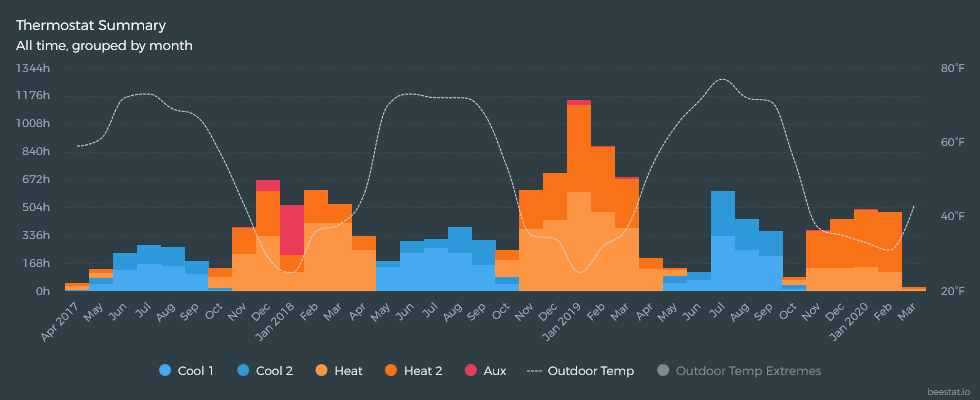I’ve had my Ecobee 3 Lite and two sensors for about 3 years, now. I’ve had it linked with Beestat for quite a while, too. I occasionally visit Beestat to admire what it tells me, but I really don’t understand what it is telling me. I don’t quite understand the graphs and such to know whether my Ecobee is running well (it seems to be, at least from a comfort perspective and also from a lower utility bill perspective). Any tips or advice on how to read these things?
You might find it useful to read some of the help pages. You can find specific ones by clicking the three dots on any card, then Help.
Alternatively, everything can be found here.
That said, understanding how to use the data can sometimes be challenging. In general, beestat doesn’t tell you if anything is wrong; it leaves that to you because it has no way of knowing what you want it to do.
Take my Thermostat Summary chart as an example:
One thing you might do here is compare months with similar average outdoor temperatures to see if your system runs more or less over time. Maybe you added some insulation or replaced some windows…you could see if those changes impacted your runtime in a positive way.


My December 2019 runtime decreased by 276 hours vs December 2018 even though the outdoor temperatures were about the same. This is due to some improvements to my home, a bit lower setpoint, and some setting changes I made to run stage 2 heat more often.
The data can be very powerful, but it does take some analysis to come to certain conclusions. There’s a lot more and hopefully others can share how they use beestat. 
Did you find running more stage 2 is better for natural gas bill?
For example after changing heat threshold from 0.5 (Ecobee default) to beestats recommended if 1.0, I noticed much more stage 2 heating. If stage 2 burns more fuel, would we want it to run less?
Kind of like when your gas light comes on in the car. If you race as fast as you can to get to a gas station, thinking I will get there sooner and spend less time on the road… you burn more fuel since your foot is hard on the pedal. If you feather it and go easy it takes longer to get there, but the engine sips less gas.
Just curious if that logic also applies to natural gas 2 stage furnaces.
I changed my stage 2 differential to 2 degrees so it won’t kick on unless it’s 2 or more degrees colder than what the stat is calling for. Now I’m back to more balanced and a little more stage 1 vs stage 2. Ecobee’s smart recovery starts to slowly ramp up heat early in the morning so there’s never that 2 or more degree jump, so there’s a little less stage 2 running now than I thought there would be. Unless we wake up cold in the middle of the night and my wife takes it up to 69 from 66.
That’s the question, isn’t it? As far as I’ve found, there is no difference in efficiency between stages regardless of fuel type. Stage 1 simply runs at 65-70% capacity.
So if you burn 0.7 units of energy per hour running stage 1, then you will burn 1.0 units of electricity per hour running stage 2. You get the same BTU per unit of energy no matter the stage.
So on the surface it shouldn’t matter at all. There are some other factors, though:
Cycling
Running stage 1 will promote longer, less frequent runtimes. These are better for your system because you will have less wear & tear from repeated heat expansion. For heat pump users, your system also operates more efficiently after it’s been running for a bit.
Comfort
In the summer especially, running the air conditioner will help reduce humidity. Assuming the humidity reduction is based on airflow and not air temperature (I don’t know if this is true), then you can better decrease humidity by running stage 1 longer. There may also be other benefits to comfort by using “less hot” air when possible.
